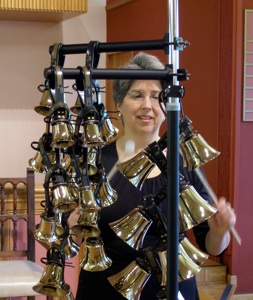In this article, I’ll cover practice tips that apply both to bell trees and bells malleted on the table, and discuss how to solve common problems. Continue reading Mallet technique: practice tips, advanced techniques
All posts by nkirkner
Mallet technique: basics
See the article on Mallets for information on buying mallets and matching them to bells.
I strongly recommend scheduling some sessions with a professional percussionist to learn proper mallet technique. Ask around for a marimba instructor: call music stores that sell percussion instruments, contact the local music schools, and ask your musician friends for recommendations. There’s no substitute for hands-on instruction by a pro. Try to have someone come to where your bells are so you can work with your equipment, both trees and table bells. Second best would be to take your bell trees to your instructor’s studio. If neither will work, you can learn a lot using the instructor’s mallets and marimba, but you’ll be on your own transferring that knowledge to bells. Continue reading Mallet technique: basics
Bell trees: composing and arranging
Today’s article will address both composing for bell trees (for trained composers) and creating your own arrangements (for bell tree soloists).
It will help to become familiar with the bell tree keyboard configuration, and choose a layout you intend the soloist to use, either the one I’ve described or the one developed by Barbara Brocker. Regardless of your intent, handbell soloists may develop their own setup for your piece, but you have to start somewhere. Continue reading Bell trees: composing and arranging
Mallets
Mallets are an external clapper mechanism. They can be used to create either a stopped sound (malleting bells on the table) or a sustained sound (malleting bells in the air, either singly or in bell trees). The object is to produce the same timbre as the clapper would. Bell manufacturers provide a variety of mallets intended for particular ranges of bells. In general, the bigger the bell, the bigger and softer the mallet. The mallets may be covered with yarn or other soft material. Smaller bells call for smaller, harder mallets, often made of rubber or plastic. Continue reading Mallets
Bell trees: equipment
The standard range for bell tree pieces using current methods is G4-G7. It’s possible to play with a much smaller range, and you could start with C5-C7 or even fewer bells. For example, the popular ‘Symphonia on Hyfrydol’ uses only C6-D7 (with F7, which could be left out) in the solo version of the bell tree part. Continue reading Bell trees: equipment
Bell trees: basics
Bell trees were discovered by Louise Frier in the 1980s. As she tells the story, she was working with mallets and also noticed handbell musicians carrying bells from their cases to the bell table by “treeing them up” (looping the handles through others to create a strand, like crocheting, or braiding a sailboat line). In one of those Aha! moments that herald innovation, she put the two ideas together and began malleting bells in trees. Over time, repertoire developed, not only bell tree parts in choir pieces, but works entirely for bell tree soloists. Continue reading Bell trees: basics
Concert planning and logistics: concert week
As I prepared for my last performance of this season, I recorded below what I think about during the week before a concert. You can read about my music preparation at Concert prep cycle – music and the logistics foundation at Concert planning and logistics: time of booking. Proper planning allows me to spread out tasks and keep everything enjoyable. I would find it really stressful to have a lot to do at the last minute. I try to organize well enough that the only thing I need to do on concert day is concert transport and the performance itself. I’ll even move some of that to the day before, perhaps packing up, or even setting up at the venue, if I can. Continue reading Concert planning and logistics: concert week
Small stuff
Being a concert solo handbell artist isn’t cheap. I’ll write another time about the major investments in equipment (like bells) and training required for a serious study of this instrument. Today’s article is about the astonishing array of “small stuff” I’ve acquired in my work as a handbell soloist. (And not so small stuff – the Bellmobile and piano both made the list!) Continue reading Small stuff
Concert planning and logistics: at booking
I like to have lots of lead time for planning concerts, and checklists help ensure nothing is missed. It can be challenging to juggle multiple engagements at different stages: concerts under discussion, concerts happening this week, and concerts coming up that need publicity. Continue reading Concert planning and logistics: at booking
Practicing without bells
Handbell musicians usually start learning the instrument without owning it. The bells may belong to your church, school, or community organization, and a single weekly rehearsal isn’t enough to learn to play any instrument well. It helps to study your sheet music at home, with the director’s permission, and to obtain recordings you can listen to in your car. Continue reading Practicing without bells

